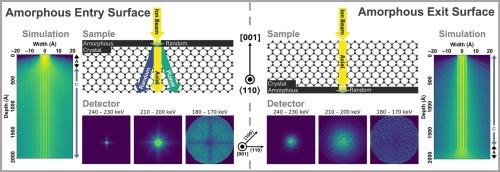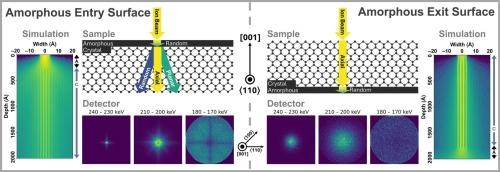单面改性硅膜中的离子束通道
IF 6.9
2区 材料科学
Q2 CHEMISTRY, PHYSICAL
引用次数: 0
摘要
利用Monte-Carlo二元碰撞近似代码(IMSIL)研究了离子(22Ne+和4He+)通过Ga注入单晶Si(001)薄膜的散射和能量分布。研究了膜在离子束方向上的[0 0 1]取向和反向取向。由于硅表面的非晶化,透射粒子的散射和能量分布都显示出对膜取向的强烈依赖。当与[0 0 1]轴对齐的离子首先遇到晶体层时,它们主要沿着轴向通道行进,然后被无定形表面层随机散射,产生随机散射分布。或者,当轨迹最初被非晶表面随机化时,很大一部分离子在进入晶体时被定向到更高的能量损失路径,如平面通道和随机轨迹。由此产生的散射分布揭示了样品的晶体特征(如星形图案),但比前一种情况具有更大的能量扩散和更高的平均能量损失。这项工作旨在将keV范围内的传输离子束成像和离子能量损失分析扩展到具有晶体和非晶态区域的复杂异质结构。本文章由计算机程序翻译,如有差异,请以英文原文为准。


Ion-beam channeling in a single-surface modified Si membrane
The scattering and energy distributions of ions (22Ne+ and 4He+) transmitted through a Ga implanted single-crystal Si (0 0 1 ) membrane are studied both experimentally and with a Monte-Carlo binary collision approximation code (IMSIL). The membrane is studied in both a [0 0 1] orientation to the ion beam as well as an inverted orientation. Both the scattering and energy distributions of the transmitted particles reveal a strong dependence on the membrane orientation due to the amorphization of the Si surface. When ions well-aligned to the [0 0 1] axis first encounter the crystalline layer, they primarily travel along the axial channel before being randomly scattered by the amorphous surface layer, yielding a random scattering distribution. Alternatively, when the trajectories are initially randomized by the amorphous surface, a large fraction of the ions are directed to higher energy-loss pathways upon entering the crystal, such as planar channels and random trajectories. The resulting scattering distribution reveals the crystalline features of the sample (e.g., star pattern) but with a larger energy spread and a higher average energy loss than the former case. This work aims to extend transmitted ion beam imaging and ion energy-loss analysis in the keV range to complex heterostructures with both crystalline and amorphous regions.
求助全文
通过发布文献求助,成功后即可免费获取论文全文。
去求助
来源期刊

Applied Surface Science
工程技术-材料科学:膜
CiteScore
12.50
自引率
7.50%
发文量
3393
审稿时长
67 days
期刊介绍:
Applied Surface Science covers topics contributing to a better understanding of surfaces, interfaces, nanostructures and their applications. The journal is concerned with scientific research on the atomic and molecular level of material properties determined with specific surface analytical techniques and/or computational methods, as well as the processing of such structures.
 求助内容:
求助内容: 应助结果提醒方式:
应助结果提醒方式:


